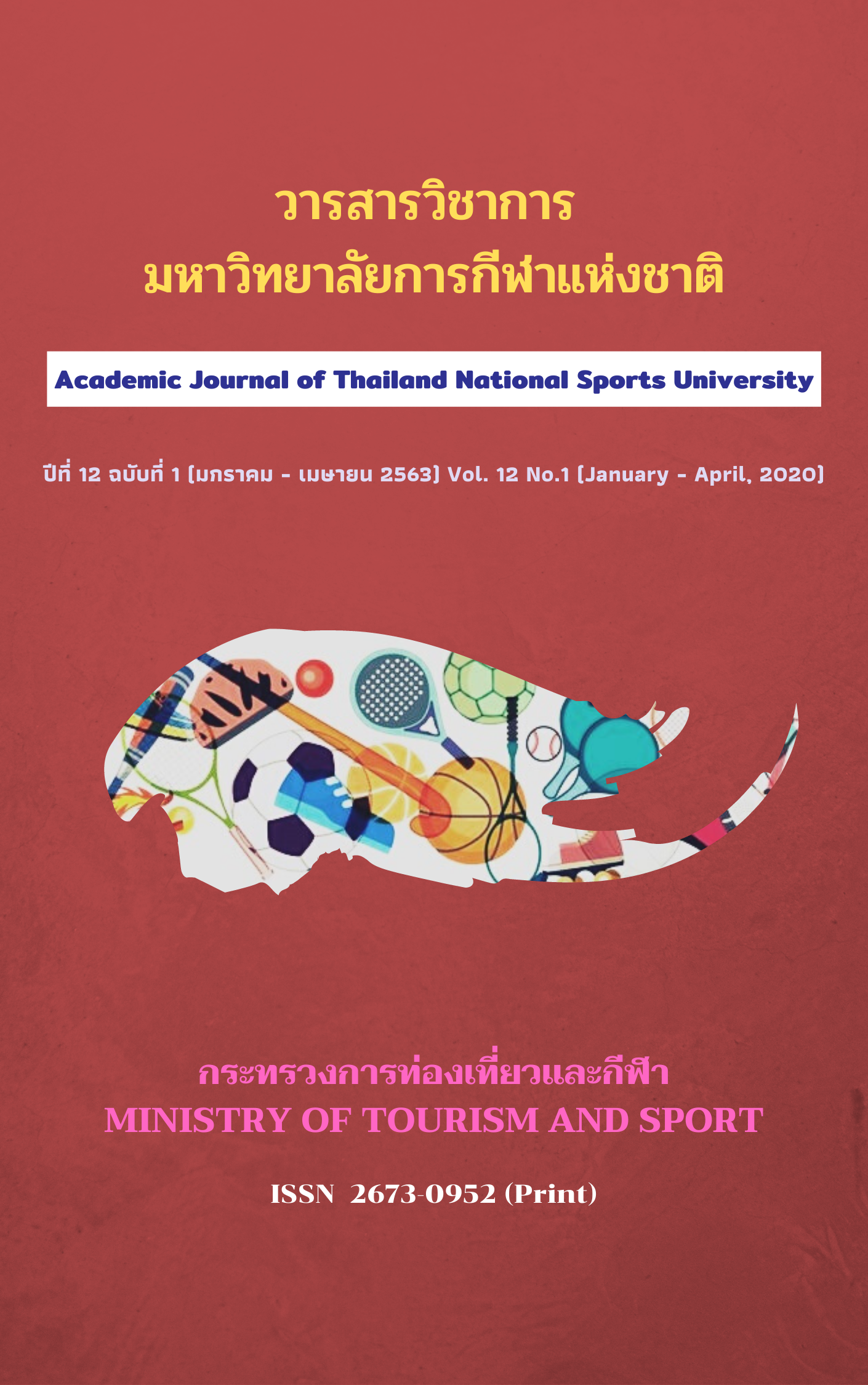MONITORING YOUNG SWIMMERS’ PERFORMANCE ON ANTHROPOMETRIC AND PHYSICAL PERFORMANCE, TETHERED FORCE, BIOENERGETICS AND BIOMECHANICS OVER A COMPETITIVE TRAINING CYCLE
Main Article Content
Abstract
The objectives of this study were to 1) study and compare anthropometric and physical performance, tethered force, bioenergetics and biomechanics over a training marcocycle and 2) study the influences of anthropometric and physical performance, tethered force, bioenergetics and biomechanics on 50 meter swimming performance in training macrocycle (12-week). Sixteen sprinter (50-100m) of Thai young national swimmers (8 males and 8 females; 16.06 +0.98 yrs), participated in this study. Mean and percentage change of an anthropometric and physical performance, tethered force, bioenergetics and biomechanics were tested and compared between pre and post-test over a competitive training cycle. Independent t-test was also conducted to evaluate any differences. Multiple linear regressions were used to identify the most influential variables and the relative contribution of each factor to changes in 50-m swimming performance.
The results revealed that fatigue index (32.50 %) and mean force (12.60%) played the main change while biomechanics and swimming efficiency and flexibility revealed a small change. The relative contributions of biomechanics and swimming efficiency showed the most influences on 50 meter swimming performance in both pre-training (86.3%) and post training 82.5%). Stroke index (63.7%) also played the main role after 12-week macrocycle in a competitive season. It was concluded that the specific marcocycle training program to improve speed performance should be adapted to specialty of swimmers in accordance with the relative contribution of strength, aerobic and anaerobic and the rate of force development training program.
Article Details
The published article is a copyright of the Academic Journal of Thailand National Sports University. The passage appeared in each article in this academic journal is a perspective of each author which is not related to the journal. Each author is required to be responsible for all components of his/her own article. If there are any mistakes, each author must be responsible for those mistakes on his/her own.
References
Chatard, J.-C., & Mujika, I. (1999). Training load and performance in swimming. Biomechanics and Medicine in Swimming, 8, 429-434.
Costa, M., Bragada, J. A., Mejias, J., Louro, H., Marinho, D., Silva, A., & Barbosa, T. M. (2013). Effects of swim training on energetics and performance. International Journal of Sports medicine, 34(06), 507-513.
Ferreira, S., Carvalho, D., Monteiro, A. S., Abraldes, J. A., Vilas-Boas, J. P., Toubekis, A., & Fernandes, R. (2019). Physiological and biomechanical evaluation of a training macrocycle in children swimmers. Sports, 7(3), 57.
Marfell-Jones, M. J., Stewart, A. D., & de Ridder, J. H. (2012). International Standards for Anthropometric Assessment. Wellington, New Zealand: International Society for the Advancement of Kinanthropometry.
Morouço, P., Keskinen, K. L., Vilas-Boas, J. P., & Fernandes, R. J. (2011). Relationship between tethered forces and the four swimming techniques performance. Journal of Applied Biomechanics, 27(2), 161-169.
Morais, J. E., Garrido, N. D., Marques, M. C., Silva, A. J., Marinho, D. A., & Barbosa, T. M. (2013). The influence of anthropometric, kinematic and energetic variables and gender on swimming performance in youth athletes. Journal of Human Kinetics, 39(1), 203-211.
Pyne, D. B., & Goldsmith, W. M. (2004). Training and testing of competitive swimmers. Handbook of sports medicine and science. Swimming, DOI: 10.1002/9780470698761.ch8.
Tanner, R. K., Fuller, K. L., & Ross, M. L. (2010). Evaluation of three portable blood lactate analysers: Lactate Pro, Lactate Scout and Lactate Plus. European Journal of Applied Physiology, 109(3), 551-559.
Tanner, R., & Gore, C. (2012). Physiological Tests for Elite Athletes. (2nd ed.). Champaign, IL: Human Kinetics
Zacca, R., Azevedo, R., Chainok, P., Vilas-Boas, J. P., Castro, F. A. S., Pyne, D. B., & Fernandes, R. J. (2018). Monitoring age-group swimmers over a training macrocycle: Energetics, technique, and anthropometrics. Journal of Strength and Conditioning Research, 32(8), 2069–2081.


